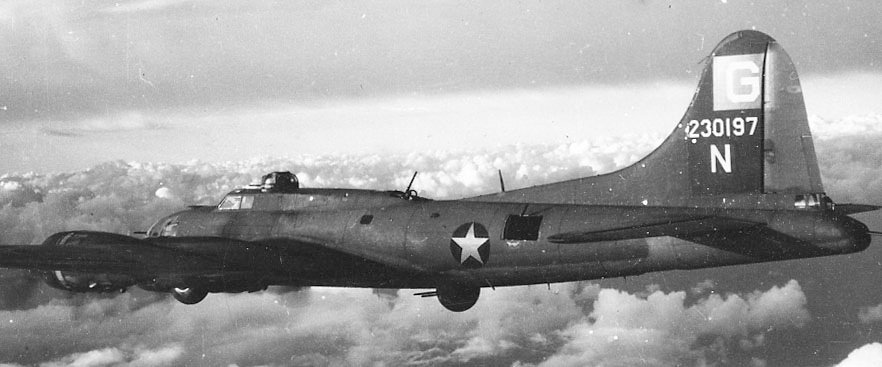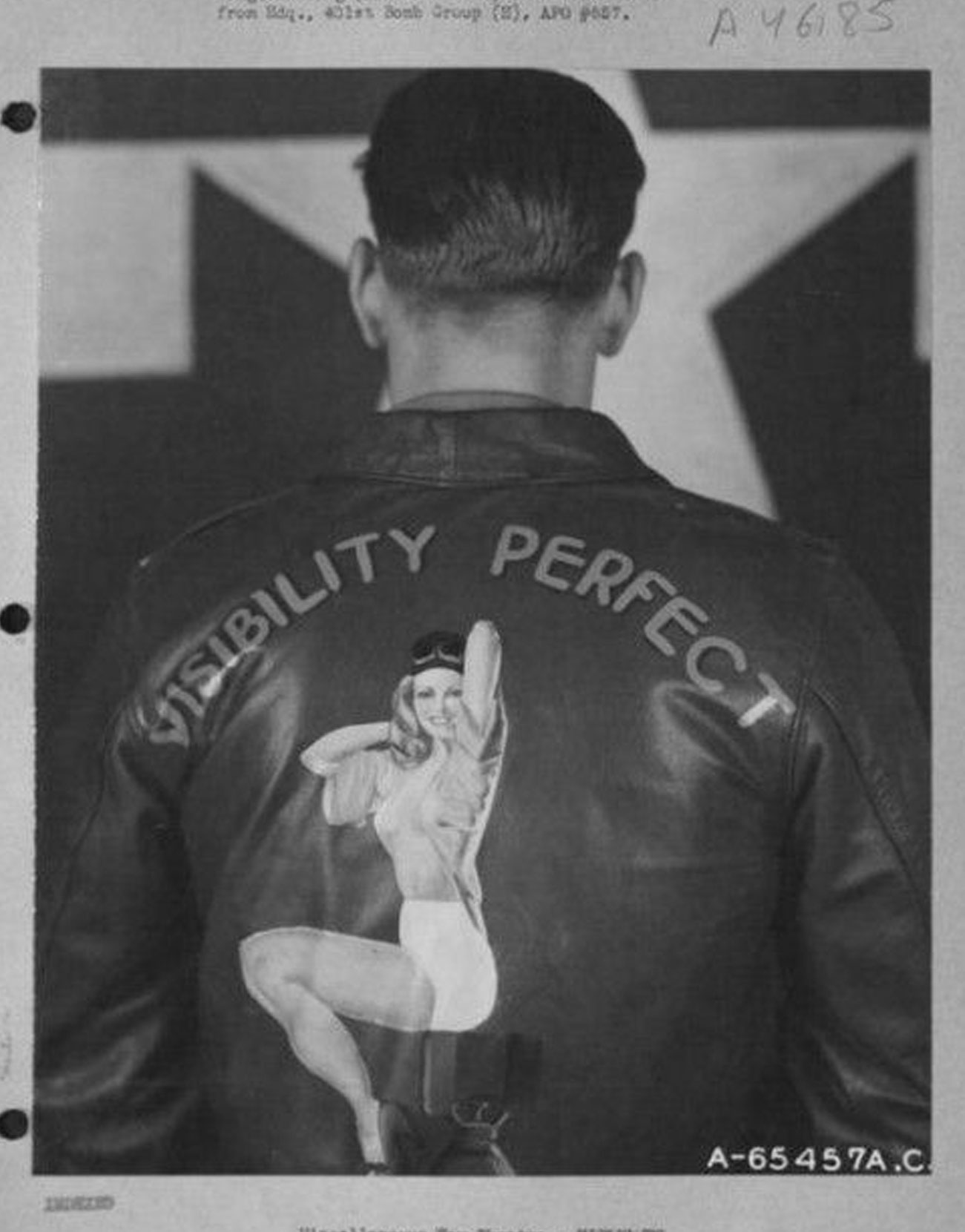What happened to B-17 ‘Visibility Perfect’, 401st Bomb Group? I have an idea it was a B-17E.
Perfect indeed, this B-17 bomber crew flew with the 401st Bomb Group. It was extremely hard to find any information on this girl, so we’ll give you folks some homework. If anyone knows anything about Visibility Perfect, let us know.
A friend painted my A-2 jacket that way, out of a picture I have in Vintage Aircraft Nose Art. We were watching B-17s last night, and got curious.
The aircraft might be mentioned in The Mighty Eighth War Diary (or it may not be), but I haven’t looked yet.
The 401st Bombardment Group’s alumni association doesn’t list that aircraft nickname in their roster of aircraft.
Lots of unnamed aircraft there. I wonder if she was one of those?
I sent an email to the Historian at your link, providing a link to the image and including the readable printed portions of the image.
Best I can tell, it was in the 614th Bomb Squadron, based on the squadron patch on the front.
Visibility Perfect | 401st Bomb Group (remember-our-heroes.nl)
But it doesn’t show up in any online nose art searches or any aircraft searches. One in particular says “Concept”, and it’s for a page that appears to produce modern replicas of historical nose art.
I searched for “B-17” “MW-H” and found this:
Missing Air Crew Report # 772
384th Bomb Group
https://384thbombgroup.com › MACR772
(https://384thbombgroup.com/_content/MACRs/MACR772.pdf)Army. RECEIVED. 1 Inel: n/c. 77 DEC 1943. Deat. MW.H … MW.H. #q. 1st Bomb Division, APO 634, 7 December, 1943 … B-17 GANKED RAIDER") WHOSE OF YOEN. SYON NAY BE …
I was unable to read much of the .pdf document, which comprises photocopies of original documents. I did not see ‘MW-H’ as depicted in the nose art on your link.
That MW-H wasn’t really a usual sort of identifier for the 8th Air Force. Typically the 8th AF planes had their group and wing defined by a letter & shape on the tail. My grandfather was in the 385th bomb group, and his bomb group had a G designating the 385th, inside a square denoting the 3rd Air Division. Another group in the same division (the 94th) had an “A” in the same square. And so on and so forth.
USAAF unit identification aircraft markings - Wikipedia
Each plane was identified by a part of the serial number on the tail- usually they’d leave the leading “4” off.
For example, here’s the “Mission Belle” (42-30197) of the 385th BG:

I suppose it could be some kind of Pacific insignia, but what makes that particular nose art really weird is that there weren’t usually any insignia right where the nose art was; that was usually on the wings and tail.
In any case, the photo PastTense posted looks original, and identifies the wearer as being from the 401st Bomb Group.
I thought you meant you flew an A-2 ![]()
Here’s the Memphis Belle:
Each side of the fuselage bore the unit and aircraft identification markings of a B-17 of the 324th Bomb Squadron (Heavy), with the squadron code “DF” and individual aircraft letter “A”.
If it was in the 614th squadron, then its squadron code would have been “IW”, and it’s wing/group insignia would have been a “S” in a triangle.
My father, Robert E. St. Ledger, was the tail gunner on the Visibility Perfect crew. I say crew because the 613th squadron history shows them as flying in several different aircraft. The pilot was John W. McGoldrick. The crew reported to the 613th in September 1944. On 9 Feb 45 mission against Lutzkendorf/Eisenach was the first mission they were a lead crew. In Mar 45, all lead crews were reassigned to the 615th squadron. The crew flew a total of 31 missions. I don’t know what the Visibility Perfect tail number was. The tail markings were a letter S, in a black triangle, with a broad yellow diagonal stripe, and a black letter K below the S. The letters KYD were on the fuselage. My father said the aircraft had a radar in place of the ball turret. That’s all the info I have.
Welcome @stledger! Tell us more about your father’s experiences in the war!
That was actually pretty standard practice. Crewmen were assigned to a specific crew and that crew to a specific aircraft, but if that aircraft was out of commission for some reason, they’d fly on whatever planes were available.
And if the whole crew wasn’t at the same mission tally, the guys who were behind would fly as replacements on other crews for wounded/sick crewman to catch up.
Beautiful aircraft. “B-17” is definitely my favourite of the shorter scenes in “Heavy Metal” written by Dan O’Bannon.
The Illustrated Biography of the B-17s and the Men Who Flew Them is a great book on the plane. It has tons of photos, production documentation, schematic drawings and pages from the training manual. If you have an account you can access the full book on the internet archive. Flying Fortress: The Illustrated Biography of the B-17s and the Men Who Flew Them
Sorry it took me so long to answer your request. My father (Robert E. St. Ledger) did not talk much about his missions. He talked more about training. He was drafted and flunked out of pilot training because he couldn’t land. He was assigned to a B-29 crew, but caught the flu and washed back to B-17 training. That B-29 crew was lost with all hands in the Pacific.
He talked about learning to shoot the .50 cal guns, and shooting skeet as part of training. He was an excellent shot with a shot gun. He sat on a board at his tail gunner station, and an one mission shrapnel entered below his seat, and exited above his seat. Either he was leaning forward at the time, or the shrapnel flew a curved path. It should have passed through his body.
In a reunion in the 80s, he found out that his pilot was not strong enough to hold the yoke back on take off, and his copilot had to help him on takeoffs. Sorry, but he didn’t talk about anything else.
Yeah, that’s something my grandfather mentioned as well. In fact, his prowess at skeet shooting was part of how he ended up a gunner; he had originally enlisted with the intention of learning how to be an aircraft mechanic.
But apparently he was extremely good at the skeet shooting and gunnery practice, so they made him a gunner. He did end up rated as a flight engineer though, so I suppose the early mechanic school wasn’t all for naught.
After he finished his 25 missions between September 1943 and the very end of December 1943 (his last mission was December 30, IIRC), he was rotated back to the US, where he taught as a gunnery instructor for the rest of the war- for B-29s! He liked them, because they were heated and pressurized, and the nerd in him really was entertained by the gunnery system. Unlike the B-17 where each gun was controlled directly by a gunner, the B-29 had gunner stations, and separate remotely controlled guns that had some sort of method for being controlled by the gunner stations. Apparently it was quite space-age for 1944, so he was intrigued by it. (this is a man who built his own color TV about a decade later from a Heathkit kit).
The funniest things he’d talk about were the comments on the crew- apparently one of the officers was considerably younger than the others, and as a result wanted to hang around with the enlisted crew who were closer in age to him. My grandfather said he’d do stuff like hide in culverts and pop out and try to hitch a ride into town and other stuff like that. My grandfather himself was nicknamed “Pops” or “Gramps” or something like that, because he was the hoary old age of 29 or so.

